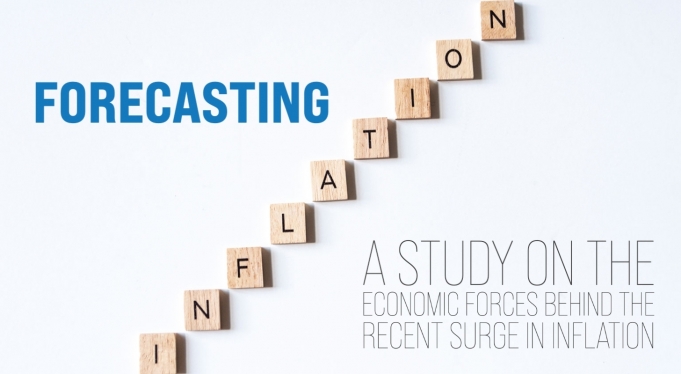Background on Inflation and the Consumer Price Index (CPI)
2021 has been a year for many microeconomic booms, busts, and uncertainties, and inflation has certainly been one of the many hot topics. The inflation rate is based on the CPI, or Consumer Price Index, which is a weighted average index of consumer goods and services. Therefore, the CPI is an index denominated in dollars, whereas often when we hear the words ‘inflation’ it is referring to the one-year percentage change in the CPI. As a result, if one year ago the CPI was very low because consumer goods and services were in a recessionary period, the one-year rate of inflation today would be quite high. This is the current economic backdrop that we find ourselves in today, but it is also a bit more nuanced than that and involves a few global economic forces at play.
Canadian Total CPI and CPI XFET (Excl. Food and Energy)
Below we have a chart of the Canadian total inflation rate (blue line) and the Canadian inflation rate XFET (black line), which excludes food, energy, and changes in taxes. One noticeable trend that we can see is that the total CPI has disconnected several times from the CPI XFET over the past decade. If the total CPI which includes food and energy is much higher than the CPI XFET which excludes food and energy, this means that the cause for the spike in total CPI was due to food and energy.
Source: https://www.bankofcanada.ca/rates/price-indexes/cpi/
Below we look at the one-year percentage change in the price of oil and natural gas over the past fifteen years. Oil and natural gas are key components to the energy aspect of the total CPI. There is a noticeable correlation between the one-year percentage changes in oil and gas and the total CPI inflation rate. Specifically, we are looking at the periods of 2008, 2011, 2018, and 2021.
Assessing Total Inflation for 2021
If we refer to the inflation graph at the very beginning of this article, we can see that in previous instances the CPI XFET was much less volatile than the total CPI, and mostly hovered around the 1% to 2% range. The exception to this is in 2021, where the CPI XFET is still below the total CPI, but it is increasing at a similar rate. The CPI XFET is currently at 3%, which is the highest reading in over a decade. This to us indicates that it is not only oil and gas prices that are causing inflation to increase, but other economic forces such as a substantial increase in the price of commodities (lumber, steel, copper, etc.) and supply chain issues causing a knock-on effect for consumer goods such as used cars.
Below we can see the substantial one-year percentage gains in the price of lumber and in used car sales in the US. It’s interesting to see that these are the largest single-year percentage gains for both of these economic factors in over ten years. These substantial increases in prices are assisting the rise of the CPI XFET (excluding food and energy) index.
Forecasting Future Inflation
As we mentioned in the introduction of this article, inflation is a one-year percentage change calculation. As is such, for inflation to hypothetically stay at 4% (today’s rate) one year from now would require all of the aforementioned forces to re-occur over the next year. This is because one year from now in September 2022, the CPI will be measured against the CPI prices from today in 2021. Oil increased roughly 75% year-over-year in August 2021, natural gas saw an increase of over 50%, lumber witnessed a roughly 300% increase, and used cars saw an increase of over 40%. In our view, these types of one-year changes are considered anomalies and are unlikely to occur again over the next year. A more likely scenario is a consolidation or slight increase of these economic forces over the next year, causing the inflation rate to be closer to the Central Bank of Canada’s target rate of 2%. We believe that the supply-chain issues causing a constraint on the automobiles market will likely be resolved within a year from now. We can also see that the prices for lumber and used cars have already begun to decline, suggesting that these inflationary forces are likely to be stifled by next year.
For added confluence, below is a chart of the US inflation rates, and it resembles the Canadian inflation chart and is impacted by many of the same forces.
What This Means for Interest Rates
With an understanding that the high inflation rate of 4.1% today is due to the combination of abnormal market conditions and comparing against the previous year’s recessionary period, we believe that inflation is likely to be lower than 4.1% by next year. A higher inflationary print causes a reaction from the central banks to increase interest rates faster to induce savings behaviours rather than spending habits. With that said, the faster that inflation decreases, the more likely it is that the central bank will prolong increasing interest rates and vice versa. A prolongation of increasing interest rates against what the market is currently forecasting would act as a tailwind for the financial markets and be a beneficiary to stocks.
Research for today, invest for tomorrow.







Comments
Login to post a comment.